Customer preferences in Klaviyo are the cornerstone of successful, revenue-driving retention for modern e-commerce brands—especially in verticals where nuance, frequency, and loyalty matter. Advanced preference strategies tailor messaging, automate journeys, and deliver CLV gains for teams serious about segment-driven growth.
Segment-driven growth is a necessity in light of the fact that:
- 79% are willing to share relevant data for immediate, contextualized interactions if privacy is respected.
- 86% of customers will pay more for a better customer experience.
- 49% leave a brand after one poor experience, even if previously loyal.
As customers expect personalized and contextual experiences, brands must collaborate with them to deliver communications that truly resonate.
As Klaviyo specialists, we’ve helped 100+ clients manage customer preferences in Klaviyo to refine their marketing. In this guide, you’ll discover how to build an effective Klaviyo customer preference strategy for leveraging preferences in Klaviyo. Let’s roll!
Why customer preferences in Klaviyo matter
Customer preferences in Klaviyo: Strategies
– Form configuration in Klaviyo & best practices
– Precision segmentation
– Automated personalization flows
– Omnichannel experience
– Real-time optimization
Setting up preferences in Klaviyo: By industry
The bottom line on customer preferences in Klaviyo
Why customer preferences in Klaviyo matter
Customer preferences are a cornerstone of effective marketing in Klaviyo because they allow for personalization and segmentation, which directly lead to higher engagement and revenue:
- Retention and revenue: Preference-based targeting can dramatically increase retention rates and lifetime value by delivering only what matters most to each segment.
- Cost efficiency: Acquiring new customers is costlier than keeping loyal ones; segmentation and preference capture save acquisition spend and focus marketing resources on high-probability conversions.
- Competitive differentiation: Brands using granular preferences for triggered messaging outsell competitors, build deeper engagement, and create advocacy loops.
Well-designed Klaviyo preference pages also act as a bridge between customer choice and brand execution, ensuring campaigns reflect true intent.
Customer preferences in Klaviyo: Strategies
Moving beyond list segmentation or demographic filters, strategic use of customer preferences lets CRM teams orchestrate sophisticated lifecycle flows, dynamic product recommendations, and real-time nurture tracks that adjust as behaviors shift.
Building an effective Klaviyo customer preferences list ensures that the brand always stays relevant while minimizing unsubscribes. By capturing this information early, marketers can personalize emails with Klaviyo preferences and dynamically improve campaign logic across the lifecycle.
Form configuration in Klaviyo & best practices
Klaviyo’s form builder is quite user-friendly, allowing for quick adjustments, image cropping, and element positioning. A pop-up can be built in about half an hour if the design is ready:
- Source tracking: When building the forms, you should also add a source code to the subscriber’s profile. This helps you track which forms are performing best and where your subscribers are coming from.
- List management: For optimal results, ensure email sign-ups go to an email list and SMS sign-ups go to a separate SMS list.
Shopify sign-ups
Shopify sign-ups can also feed directly into Klaviyo subscriber preferences when tags and marketing consent settings are properly applied in the theme.liquid file. This sync provides a clean foundation for segmentation and setting up preferences in Klaviyo.
Precision segmentation
Segmentation in Klaviyo goes far beyond basic demographics. With the right data points, brands can create highly targeted groups that drive meaningful engagement:
- Behavioral segments: Group customers based on site interactions, purchase cadence, cart size, and product affinity for truly dynamic audience targeting.
- Predictive segments: Use Klaviyo’s predictive analytics to identify churn risk, likelihood to buy, and optimal re-engagement windows, feeding proactive marketing automation.
- Preference collection: Zero-party data collection via quizzes, preference centers, review forms, and post-purchase surveys can power hyper-personalized recommendations and campaign logic.
This approach forms the core of Klaviyo segmentation by preferences, ensuring that inclusion and exclusion lists maximize engagement while safeguarding deliverability.
Effective segmentation is the backbone of email marketing in Klaviyo. By knowing who to include and who to exclude, you can maximize engagement, protect deliverability, and send the right message to the right audience. The tables below outline the key inclusion and exclusion segments every brand should maintain as part of a sustainable email strategy. (Source: Flowium)
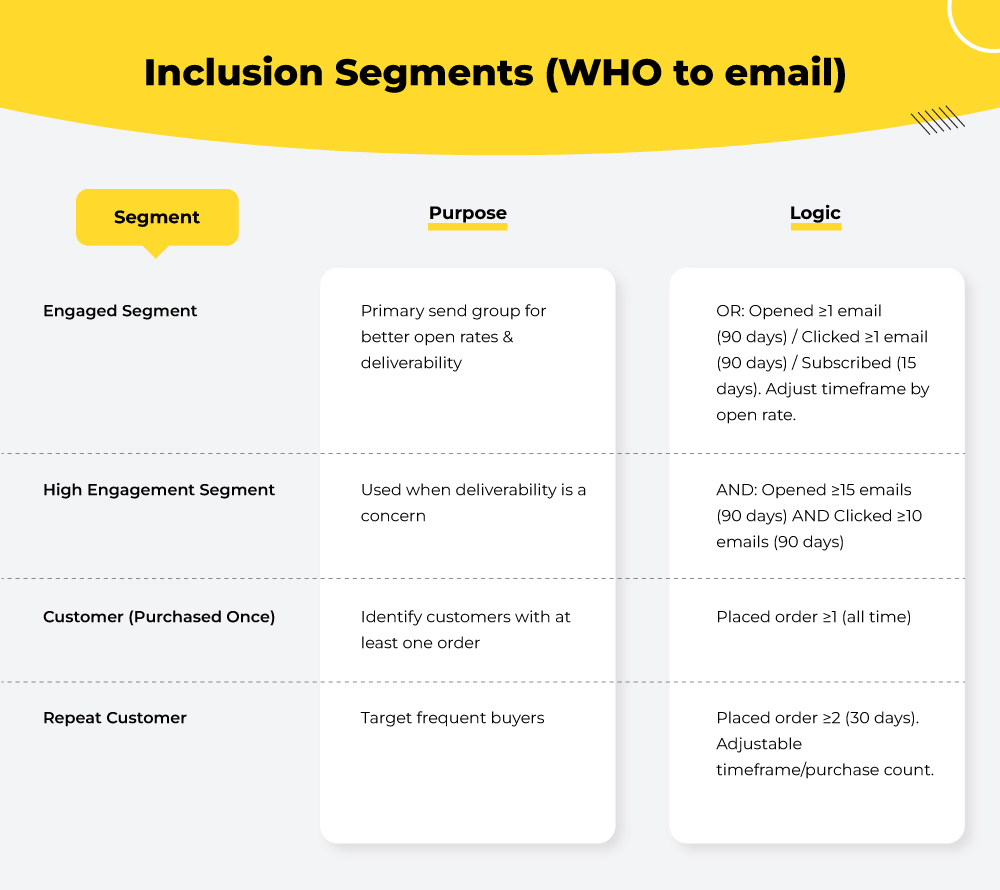
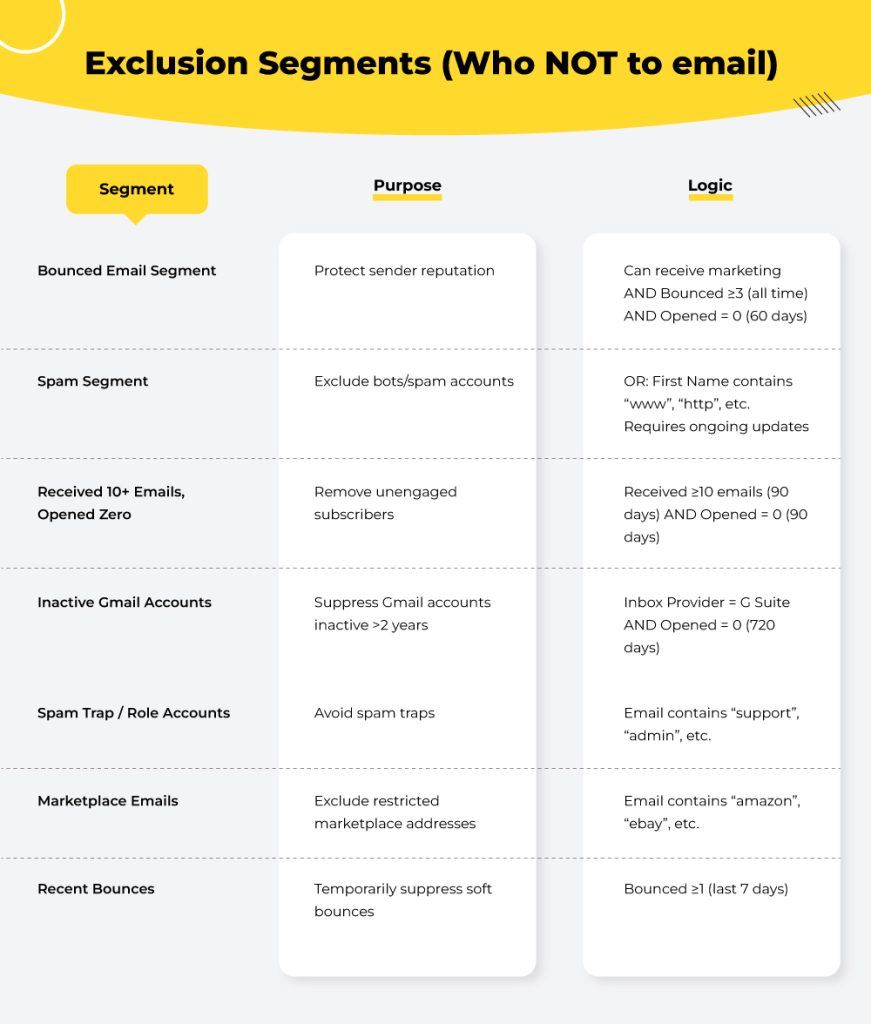
If you’re using Klaviyo’s Segments AI, remember they come with risks, such as misinterpreting prompts (e.g., using “equals” instead of “contains”), omitting key conditions like accounting for new subscribers in engaged segments, and creating false confidence for inexperienced marketers who may not spot flaws. Additionally, the prompt field’s character limit restricts detailed instructions, making it harder to capture complex or nuanced segmentation needs.
Automated personalization flows
Personalization at scale is possible when flows are designed to respond directly to customer intent and preferences, making every message feel timely and relevant:
- Welcome series: Tailor sequences based on sign-up source, stated interests or loyalty tier for instant relevance.
- Abandoned cart and browse flows: Trigger with abandoned SKUs and match follow-up content to the product category or urgency level preferred by the segment.
- Abandoned search flows: Since an abandoned search shows stronger purchase intent than an abandoned browse, use a conditional split in Klaviyo to route these customers into a targeted search flow. Set the trigger window shorter—around 5 days compared to 10 for abandoned browse.
- Replenishment and subscription flows: Calculate reorder windows based on past behavior and preference-captured product usage patterns; include timely refills, loyalty incentives, or cross-sell offers.
One of the most effective ways to personalize emails in Klaviyo is through product feeds. These allow you to surface products that are most relevant to each customer, based on either manual selection or dynamic rules. You can use static feeds to hand-pick specific products or dynamic feeds that auto-generate product recommendations—like bestsellers, most-viewed, newest, abandoned-cart items, or AI-powered “you may also like” suggestions.
Product blocks are fully customizable—adjust layout, product count, sizing, and even highlight discounts with different price colors. While they can increase engagement and click-throughs, keep an eye on email size since heavy blocks may trigger Gmail clipping.
Dynamic feeds combined with personalized emails with Klaviyo preferences ensure each message feels curated rather than generic.
Omnichannel experience
Customers don’t interact with brands on just one platform. A cohesive strategy ensures that their preferences follow them seamlessly across every channel they use:
- Channel Affinity mapping: Klaviyo’s channel affinity models analyze engagement data from each customer to identify not just preferred channels, but also optimal send times and message types. Use this insight to dynamically route campaigns so that each customer receives messages on the channel where they act fastest, adjusting in real time as behaviors shift.
- Lifecycle flow branching: Build journey automations that branch dynamically based on profile variables and behavioral events—such as a customer crossing a loyalty threshold, engaging in-store, or leaving a review. These branches can instantly trigger highly targeted offers or educational content based on Klaviyo customer journey customization.
- Unified data activation: Integrate Klaviyo with Shopify, WooCommerce, POS, Meta Ads, and Google Ads, ensuring all customer events refresh segments and trigger communications with no lag. Use the platform’s native connections and real-time sync to unite CRM, commerce, and ad platforms into a single responsive ecosystem.
- Anonymous activity backfill: Apply Klaviyo’s web pixel and Shopify integrations to track and profile anonymous visitors before signup. Use pre-signup behavior (viewed categories, interactions, time spent onsite) to personalize your messaging upon capture.
- Event-triggered localization: Activate dynamic content based on location, seasonality, or live contextual events using Klaviyo’s flow logic and integrations. Push region-specific product recommendations or incentives to a few select segments on different channels.
Real-time optimization
Effective marketing isn’t static. Constant testing and dynamic preference management keep campaigns sharp, accurate, and customer-led.
A/B testing in Klaviyo
By experimenting with different elements across flows, campaigns, and forms, you can uncover what resonates most with your audience and continually improve results. Consider the following tips and recommendations as suggested by Konrad Wysocki of Ventive Email:
- Test time delays (12h vs. 1–2d), email format (plain text vs. design), copy (short/long, branded/direct-response), CTAs (wording/colors), email order (social proof early vs. later), and flow duration.
- Test send time/date (via Klaviyo or Shopify analytics), campaign angles, pricing visibility (price shown vs. hidden), product display (AI-driven vs. manual), and execution method (prefer 50/50 splits for cleaner datasets over “winner sends”).
Aim for 3K–5K recipients per variation or at least 2 weeks (max 2–4). Start with time delay tests, then email order, subject lines, and others as needed.
- Test your sign-up forms. The main goal is to improve the submission rate. Compare offer type ($10 OFF vs. 10%), regular vs. mystery offers, multi-step vs. single-step forms, full-screen vs. image pop-ups, discount shown vs. hidden on thank-you page, with vs. without reviews, and trigger timing (scroll % vs. time on page).
Run tests for at least 15 days or until each variation gets 3K–5K impressions; daily high-volume brands should still run the full 15 days. - A 50/50 split gives better data and ensures optimal send time. Short test windows (2–3h) can miss delayed opens or clicks. Therefore, run exploratory send-time tests 2–3 times, then refine other variables as needed.
Exploring how Klaviyo customer preferences impact flow effectiveness should be a recurring part of optimization cycles.
Dynamic preference center
One of the most common questions we get is how to collect data on the preference page without flooding the form with too many form fields. Here are a few ways of doing it:
- Use hidden fields or cookies to recognize returning subscribers and present them with new, relevant questions each time they visit the preferences page.
- Instead of asking for detailed demographics, offer subscribers a simple list of email content categories that they can select with a single click.
- Simplify frequency choices into a few clear, benefit-driven tiers.
- Integrate a rotating, single-question survey on the preference page.
- Use a visual interface, such as a slider or a set of icons, to represent frequency or content interest. For example, a slider from “Just the Essentials” to “All the Latest.”
Over time, this builds a high-value Klaviyo customer preferences list while preventing form fatigue.
Setting up preferences in Klaviyo: By industry
Every industry collects and applies customer preferences differently. Tailoring your approach ensures you’re gathering the most relevant data points and using them to drive more effective personalization. Below is a curated list of key preferences and CRM data fields for five high-value e-commerce sectors. Each segment is tailored to their unique buying cycles and value drivers, tested in live Klaviyo implementations.
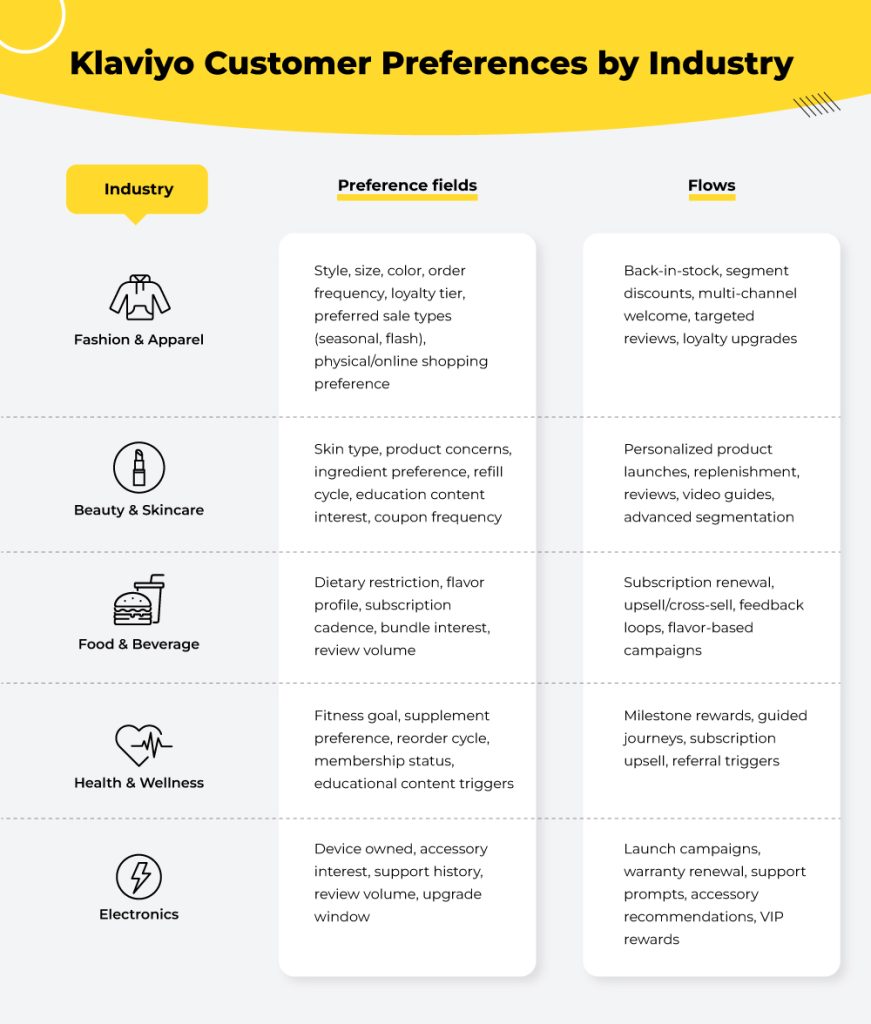
Don’t just collect preferences—operationalize them.
Map each field to a measurable business outcome (e.g., higher LTV, lower churn) and set review cadences to retire unused fields. The next frontier is preference agility: shorten the lag between captured preference and personalized action, A/B test preference-driven logic in flows, and layer predictive analytics to anticipate needs before customers express them.
Benchmark preference data usage across industries—what drives repeat purchases in beauty may drive warranty upgrades in electronics.
This discipline turns preference collection into a growth lever, not just a data exercise. Consider these effective tips from our team:
- Retire unused fields and refresh preference options to stay relevant. Add relevant rules to auto-expire outdated preferences.
- A/B test how preferences shape flows (e.g., loyalty tier in welcome series, skin type in replenishment).
- Use predictive overlays. Combine captured preferences with Klaviyo’s predictive analytics to anticipate needs.
- Periodically prompt your customers to update their settings, disguised as style updates, seasonal guides, or “unlock your perks” campaigns.
The bottom line on customer preferences in Klaviyo
The brands that win will be the ones that stop merely collecting data and start activating it.
Manage customer preferences in Klaviyo with agility, connect them to measurable business outcomes, and continually test their influence on flows.
Ultimately, the most successful teams use Klaviyo segmentation by preferences to build scalable, profitable, customer-led experiences. The real differentiator is not collection, but how quickly you act on an email preference list in Klaviyo in order to fuel growth.
If you’re ready to unlock growth with a refined Klaviyo preference center, let’s talk. Our team has already helped 100+ brands operationalize Klaviyo email preferences into revenue—and yours could be next. Connect with us for a 30-min no-obligation call today!

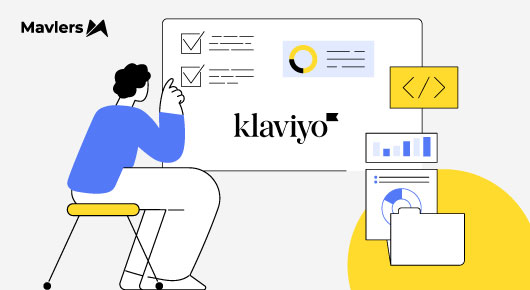

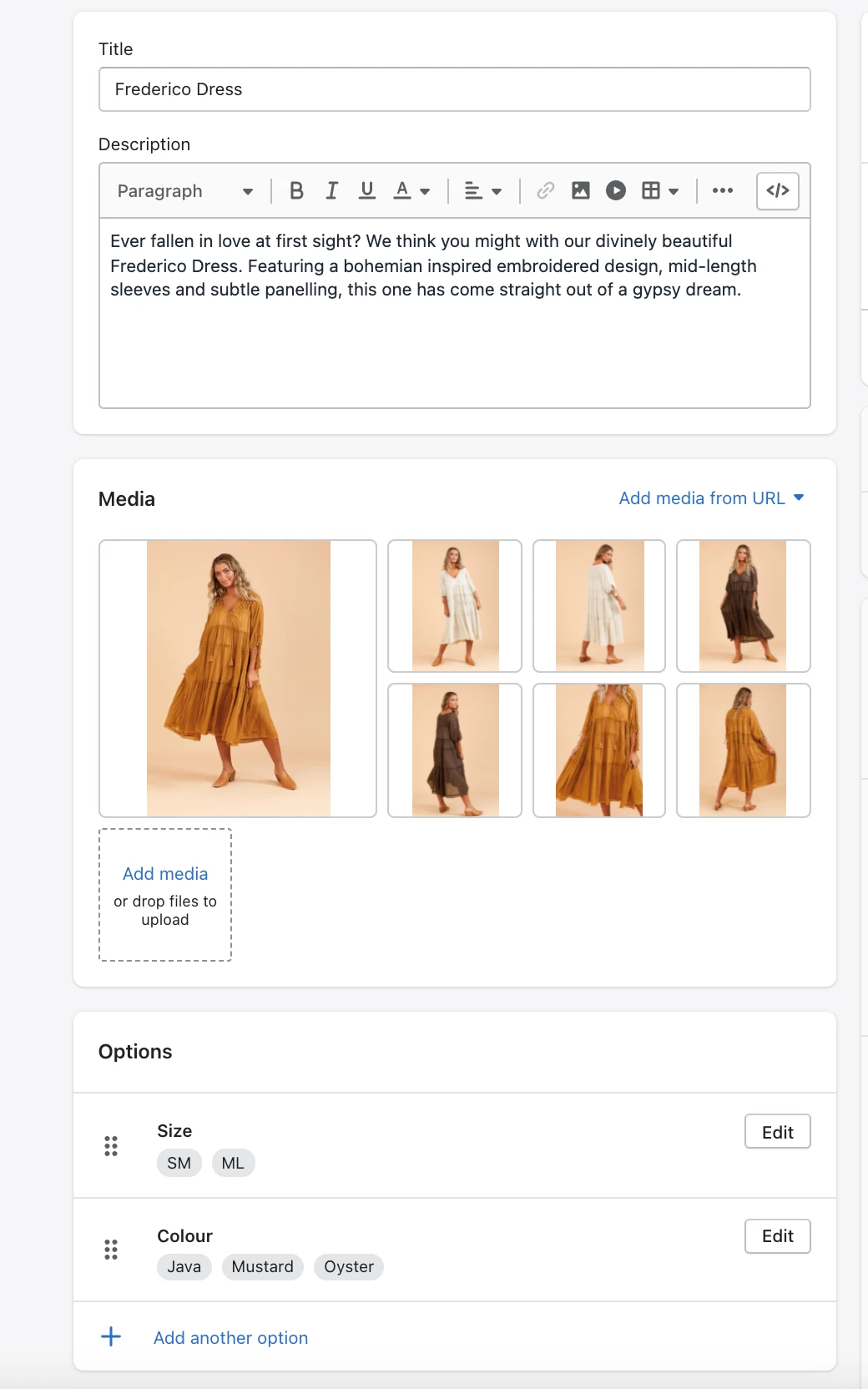
Chintan Doshi - Reviewer
Chintan is the Head of Email & CRM at Mavlers. He loves email marketing and has been in the industry for 7+ years. His track record of email marketing success covers building email programs from scratch and using data-driven strategies to turn around underperforming accounts.
Susmit Panda - Content Writer
A realist at heart and an idealist at head, Susmit is a content writer at Mavlers. He has been in the digital marketing industry for half a decade. When not writing, he can be seen squinting at his Kindle, awestruck.
From engagement to retention: Predicting & boosting HubSpot customer success
AI in local SEO: Your new secret weapon or just another shiny tool?